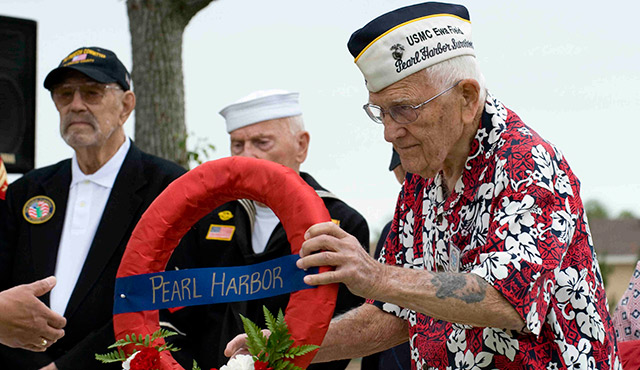At 97, John Hughes spends most of his time these days relaxing. He loves to read history books — he calls the Bible the “greatest” history book — and rarely turns on the TV.
“I guess the term would be milling around,” the longtime Santa Ana resident says with a laugh.
Hughes has earned his down time.
A fixture at St. Joseph Church, where he has been a parishioner since 1961 and until a few years ago was a familiar face at the 9 a.m. Sunday Mass, where for years he served as an usher, Hughes is a decorated military veteran and member of a rare and disappearing breed of American hero: a Pearl Harbor survivor.
Hughes was 22 and stationed at the air base Ewa Airfield on Oahu when, at 7:55 a.m. local time on Dec. 7, 1941, Japanese fighter planes attacked Pearl Harbor.
The infamous assault, that plunged the U.S. into World War II for four years, lasted less than two hours and killed more than 2,400. More than 1,000 people were wounded, and nearly 20 U.S. ships and 300 U.S. airplanes were damaged or destroyed.
Hughes, one of only about 2,000 Pearl Harbor survivors thought to still be alive out of a pool that once totaled 30,000, recently discussed that morning — one of the darkest in U.S. history — and why he believes it’s important to never forget that day, and how his faith has kept him strong.
“I have God to thank for getting me through the war safely, and I thank him for every new day,” Hughes says.
Fateful morning
Hughes was 22 and a Marine Corps sergeant. He had just eaten breakfast when he noticed the morning newspaper had yet to arrive.
He went out to look for the delivery guy.
“Then, I saw a low-flying plane go by over the sugarcane, a plane with a red ball on the side, so I knew what that meant,” says Hughes, referring to the feared Japanese “Zero” fighter planes.
Word around Ewa Airfield for a while had been that the Japanese were up to something.
Now Hughes and his comrades were realizing all too vividly the horrors that were about to be unleashed on U.S. troops at Pearl Harbor.
Hughes ran to tell his fellow servicemen to break out the ammo because “the Japs have arrived.”
With Japanese Zeroes coming in low and strafing Ewa Airfield, Hughes concentrated on getting shots off at the attacking planes from his 1903 Springfield rifle.
He and others then pushed airplanes away that weren’t on fire to keep them from getting damaged by the U.S. planes that already were smoldering.
“We lost 30 or so planes — they were totally destroyed — and the rest were damaged,” Hughes recalled. “We didn’t have one that wasn’t damaged. It was a pretty big deal on their [Japanese] part. They did a really effective job.”
Four of Hughes fellow Marines died at Ewa that morning.
Did Hughes ever feel in danger?
“I recall feeling I could be shot, yes, but I wasn’t worried about it,” Hughes said. “My job was shooting. I didn’t have time to be afraid. I just did my job.”
After the attack, Hughes and others cleaned up the mess.
“When we saw the massive loss at Pearl Harbor, we were devastated, saddened and irate,” Hughes said. “It was a mixture of strong emotions all together.”
As Hughes sees it, he and other U.S. servicemen were just doing their jobs that day.
“I don’t think I was a hero,” Hughes said. “I did was I was supposed to do.”
Distinguished career
Hughes went on to a distinguished military career that ended in 1964 after 27 years of service.
A combat pilot, Hughes ended up flying more than 150 dive-bombing missions during his multiple tours in the South Pacific during WWII and the Korean War, where he also flew helicopters as a member of a medical EVACS team.
His numerous military commendations include the Distinguished Flying Cross.
After retiring from the Marines Corps, Hughes managed a liquor store in Santa Ana while he and his wife, Mary, raised five children.
Hughes stopped working in 1981, at age 62. Mary died in 1992 at age 72.
Never forget
Hughes recently returned from Hawaii after attending, with several relatives, ceremonies marking the 75th anniversary of the attack on Pearl Harbor.
“It’s always good going out there,” he said. “It was a great trip.”
Ewa Airfield was added to the National Register of Historic Places in May 2016.
Hughes turns 98 on Feb. 8. He attributes his long life, in part, to lifting weights for several years.
Since Hughes has outlived most of his contemporaries, most parishioners at St. Joseph Church in Santa Ana have no clue they have a Pearl Harbor survivor in their midst.
“To the younger people today, World War II is like the Civil War was to me when I was a kid,” Hughes said. “I don’t think that young kids today really think about (Pearl Harbor). It’s history. It’s 75 years ago.”
But remember they should, Hughes said.
“It could happen again — not to say the Japanese (will attack), but someone else. Keep alert: That’s the main thing. And never take your freedom for granted.”

